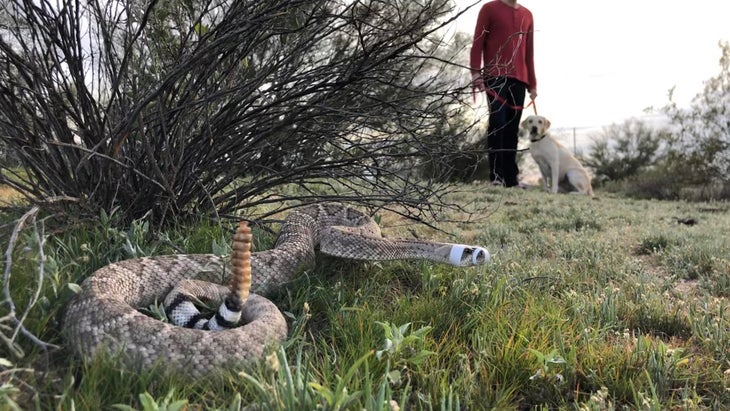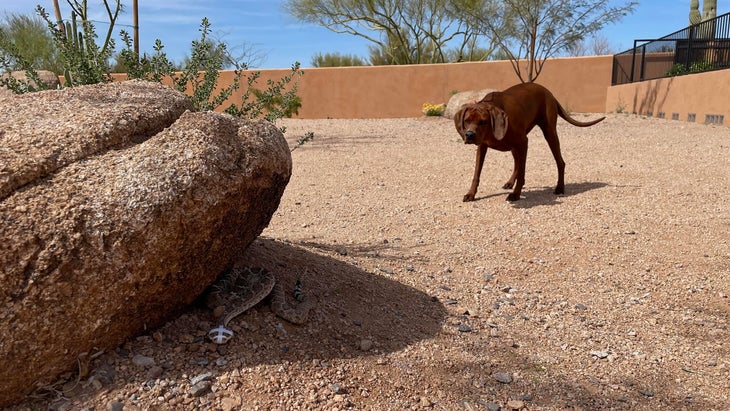You’re clomping along with your four-legged best friend down a sunny stretch of trail when, out of nowhere, you hear it—the shcka shcka shcka of a rattlesnake’s tail. The creature is sprawled across the length of the hiking path, and there’s no safe way around. It’s every pet owner’s worst nightmare.
If a rattlesnake bites a pet, severe localized swelling can occur at the site of the puncture wound, most commonly on a dog’s face or extremities. Twenty to thirty percent of all rattlesnake bites to pets are dry bites, meaning that no venom is released, but if a pup starts showing signs of envenomation–bleeding, limping, depressed respiration, or muscle tremors–it’s critical to get them to a vet as quickly as possible to increase their chance of survival. Severe reactions to snake hemotoxin and neurotoxin , in which the skin and muscle surrounding a bite become purple and blackened, with a corresponding drop in blood pressure.
As temperatures rise, wildflowers bloom, and days lengthen, any outdoor-loving dog owner knows that means rattlesnake season is here. It’s a reasonable cause for anxiety— bite 150,000 pets each year in the U.S., and die from these bites. But experts say that most dogs can learn to keep a safe distance after attending a rattlesnake avoidance training course.

“Being curious, domesticated animals, dogs experience much of the world through their nose and without much caution,” says Cody Will, owner of in Cave Creek, Arizona. “This is a bad combination when venomous snakes are brought into the mix. Dogs simply don’t know rattlesnakes are dangerous and often investigate a rattlesnake too closely when encountered. This can end up putting them in the emergency vet overnight and costing their owners thousands of dollars.” (A vial of antivenom, the main treatment for a bite, can cost $600 to $1,000, and many dogs will need more than one vial, plus emergency room fees.)
Ultrarunning champion and writer Katie Arnold discovered this the hard way, when her black lab, Pete, grabbed a rattlesnake with his mouth while swimming in the Rio Chama in New Mexico. “We saw the snake bite him above his eye and then he dropped it,” she says, adding that it took nearly three hours to get the dog to the nearest emergency vet in Santa Fe. “Thankfully he was okay, but when we picked him up the next day, his head had swollen to twice its normal size; he looked like a Shar-Pei.” She estimates that, without pet insurance, the ordeal would have cost roughly $8,000.
Rattlesnake aversion courses, which are typically 30 to 40 minutes long and cost $120 to $225, are common in warm, snake-populated states like California, Utah, Arizona, and Colorado. Most trainers set up a walking course in a controlled, natural setting that owners and their dogs navigate while the dogs wear a low-intensity shock collar. Trainers place live, muzzled rattlesnakes in different areas around the course and assess a canine’s response in different situations. “The dogs are introduced to the different components of sight, sound, and scent in different stations that you walk to,” explains Gina Gables, founder of in Ventura County, California. If a pooch gets too close to one of the muzzled snakes, a mild zap of the collar teaches them to back off.
After the dog has learned to stay away from snakes based on sight, they move on to sound and smell setups. Hidden Bluetooth speakers playing intermittent rattling isolate the natural noise of a snake, which teaches the dog to avoid the potential unseen danger. Finally, the pups walk past a hidden snake with a taped rattler or a strip of freshly shed skin to make sure they can identify these trail threats by scent alone.
Arnold, author of the memoir , has since taken her dog to two of these trainings. After walking Pete through the course with and without a shock collar, he had a firm grasp of the core training: don’t mess with rattlesnakes. When she took him back for a refresher, Pete remembered immediately. “He got within 100 feet of the snake, smelled it, tucked his tail, and began shaking, then literally pulled the leash out of my hand and started trotting away. This was five years after his first training,” she says.

Rattlesnake Avoidance Training: How to Find a Course
Though many such courses exist across the country, not all are created equal. Recreating dog owners should shop around and ask about the length of time they’ll get to spend on the course with their pet, as well as how the captive snakes are treated. “One pitfall of the training, in my opinion, is the requirement to use real rattlesnakes,” says Will. “It’s caused a lot of the wrong sorts of people to be keeping or outright abusing venomous snakes.” He went on to explain that he sources his training snakes via backyard and development site removals, then houses them in an educational nature center that visitors are welcome to check out. On the morning of an avoidance course, each snake is muzzled with a special medical tape, then returned to its glass enclosure in the evening, sans-tape. “The snakes only work one day a week, on average, during our busiest season,” he says.
If you can’t find a course near your home, but you know your furry friend will be tagging along on a potentially snake-heavy hike or road trip this year, there are still things you can do to keep your pet safe around rattlers, says Kelly Sosa, founder of in Atascadero, California. “If you and your dog encounter a rattlesnake on a trail, the best thing to do is to stay calm and cheerfully call your dog to you while backing up,” she says, noting that it’s crucial not to get angry and risk scaring your pooch away from you and closer to the snake. “Your best tactic is to be more fun and exciting than the distraction to encourage your dog to leave the snake and come to you.” Will also mentions that good recall skills—making sure your dog knows its name and will come to you, even when agitated—are essential on any trail. “Don’t ever assume the dog will leave the snake alone,” he says.
Dog-toting recreationists should also always carry the nearest emergency vet’s phone number with them to prepare for a worst case scenario. At the top of Sosa’s list to have in your kit for pet safety? Tweezers, Benadryl (without xylitol, which is poisonous to dogs), and hydrogen peroxide (to induce vomiting if a dog ingests a toxic item).
Even after multiple opportunities to walk around a comprehensive course, pet parents shouldn’t immediately assume that their four-legged friend is omniscient when it comes to recognizing snakes in the wild. “Even the best trained dog can still miss a well-hidden snake under tricky circumstances,” Will says. “Rattlesnakes are very cryptic masters of camouflage.”
“Your dog isn’t constantly on cue to be searching for rattlesnakes,” adds Gables. She recommends that first year trainees attend two different courses in separate locations to solidify the training.
Having a well-trained dog that’s able to detect snakes before an owner ever sees them increases safety for humans, too, note both Will and Gables. After all, canines have much more acute senses of hearing and smell than we do. “The training combats negative interactions between people and wildlife in general, which is important,” says Will.
Treading lightly, learning proper safety protocols, and minimizing our impact on the places we love are essential for everyone’s enjoyment of our public lands, whether they be two-legged, four-legged, or slithering.


